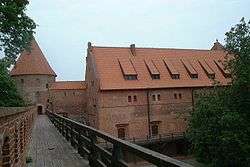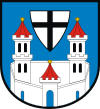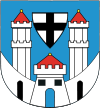Bytów
| Bytów | |||
|---|---|---|---|
|
Teutonic castle in Bytów | |||
| |||
 Bytów | |||
| Coordinates: 54°8′N 17°30′E / 54.133°N 17.500°E | |||
| Country | Poland | ||
| Voivodeship | Pomeranian | ||
| County | Bytów County | ||
| Gmina | Gmina Bytów | ||
| Established | 12th century | ||
| Town rights | 1346 | ||
| Government | |||
| • Mayor | Ryszard Sylka | ||
| Area | |||
| • Total | 8.72 km2 (3.37 sq mi) | ||
| Population (2006) | |||
| • Total | 16,715 | ||
| • Density | 1,900/km2 (5,000/sq mi) | ||
| Time zone | CET (UTC+1) | ||
| • Summer (DST) | CEST (UTC+2) | ||
| Postal code | 77-100 | ||
| Area code(s) | +48 59 | ||
| Car plates | GBY | ||
| Website | http://www.bytow.com.pl | ||
Bytów [ˈbɨtuf] (Kashubian: Bëtowò; German: Bütow (![]() listen) is a town in the Gdańsk Pomerania region of northern Poland in the Bytów Lakeland with 16,888 inhabitants (2004). Previously in Słupsk Voivodeship (1975–1998), it is the capital of Bytów County in Pomeranian Voivodeship (since 1999).
listen) is a town in the Gdańsk Pomerania region of northern Poland in the Bytów Lakeland with 16,888 inhabitants (2004). Previously in Słupsk Voivodeship (1975–1998), it is the capital of Bytów County in Pomeranian Voivodeship (since 1999).
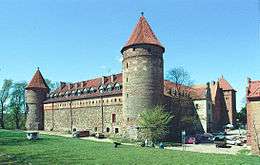

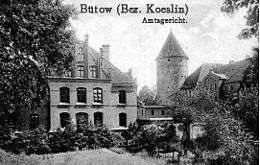
History
According to the city's official webpage the name Bytów comes from the founder of the settlement named "Byt".[1] An old Pomeranian settlement was first mentioned by Latin name castrum nomine Bitom in 1113 in Gallus Anonymus' Chronicle, as conquered by Polish king Bolesław III Wrymouth.
The Teutonic Knights had started in 1335 with the construction of a rectory. The castle seen today was built by the Knights between 1399 and 1405.[2] It has been the site of an administrator of the State of the Teutonic Knights.
This castle was captured by Poland after the Battle of Tannenberg (1410), and king Jagiello of Poland gave it to Bogislaw VIII, Duke of Pomerania, for all of his lifetime as payment for support obtained from him against the Teutonic Knights. In the Peace of Thorn (1411) Bogislaw had to return the castle to the Knights. The town did not join the Prussian Confederation's revolt against the Teutonic Knights.
The town alternated between Poland and the monastic state during the Polish-Teutonic Wars, and returned to Polish control after the Second Peace of Thorn (1466). Poland gave Bytów as lien to the Dukes of Pomerania. Since 1526 the Pomerania dukes held it as an inheritable lien.
In 1627 during the Thirty Years' War, the town was rebuilt after being destroyed by a fire. When the Pomeranian dukes died out in 1637 the town ceased to be a Polish fief and became directly ruled by Poland. To gain an ally against Sweden during the Deluge, in 1657 King John II Casimir of Poland gave the Lauenburg and Bütow Land to Margrave Frederick William of Brandenburg-Prussia as a hereditary fief in the Treaty of Bromberg. Although Poland still retained sovereignty, the town was administered by Brandenburg and, after 1701, by the Kingdom of Prussia. During the 18th century, the town suffered from fires and plague.
In 1773 in the First Partition of Poland the town was wholly incorporated in the Prussian Province of Pomerania. From 1846-1945, Bütow was the seat of the Landkreis Bütow district in Prussia. The town became part of the German Empire in 1871 during the Prussian-led unification of Germany. Polish minority remained active in the city, and in 1910 a Polish Bank Ludowy was founded here.[3]
Although reconstituted Poland desired Bütow at the end of World War I, the Treaty of Versailles kept the town in the Weimar Republic in 1919. The decision led the local Kashubians to protests and hundreds of them took part in march known as "marsz na Bytów".[4][5]
According to Polish sources the Bytów area remained the main centre of activity by Polish minority in the region and in 1923 Związek Polaków na obszar Kaszubski (Organization of Poles in the Kashubian Region) was founded in the city.[6] In 1928 Jan Bauer, a Polish teacher organised Polish language lessons, and reinvigorated the Polish movement in the city, which resulted in repressions by German state, and his eventual conviction and exile from Germany in 1932. Finding himself at the outbreak of Second World War in Berlin he was arrested and murdered by the Nazis in 1940.[7]
Bütow was captured by the Soviet Red Army on 8 March 1945. Some inhabitants had fled before the Soviet advance. In 1945, after the end of the war, the town was put under Polish administration according to the Potsdam Conference and renamed to the Polish Bytów. Those German inhabitants, which had remained in the town or had returned to it short after the war, were later on expelled[8] and replaced with Poles, who first came mainly from regions east of the Curzon Line, which had been annexed by the Soviet Union.
Bytów became the seat of a powiat (1946–1975, 1999-) within Poland.
Kashubian Emigration to America
During the Kashubian diaspora, many families from Bytów such as the Brezas and the Pehlers emigrated to the area of Winona, Minnesota in the United States, beginning in the late 1850s. The Prussian policy was to force the Kashubians out to make room for German settlers. Life was grim for the Kashubians and many migrated to the U.S. settling in Pine Creek, Wisconsin and many from the Bytów area began settling in a growing Kashubian community in Winona, Minnesota beginning in the 1860s. Many found jobs in the lumber mills during the lumber boom of the late 1800s occurring in the region.[9][10]
Demographics
Up to the end of World War II most inhabitants of the town were Protestants.
- Number of inhabitants by year
| Year | Number |
|---|---|
| 1782 | 990 |
| 1794 | 1,085 |
| 1812 | 1,217 |
| 1816 | 1,395 |
| 1831 | 2,062 |
| 1852 | 3,509 |
| 1861 | 4,247 |
| 1875 | 5,820 |
| 1900 | 6,487 |
| 1925 | 8,890 |
| 1960 | 8,600 |
| 1970 | 10,700 |
| 1975 | 12,500 |
| 1980 | 13,300 |
| 2011 | 20,943 |
The above table is based on primary, possibly biased, sources.[11][12]
Notable residents
- Wilhelm Abel (1904–1985), German economist
- Adolph Ferdinand Gehlen (1775–1815), chemist
- Szimón Krofey (1545-1590), pastor and publisher of Kashubian-language Lutheran texts
- Hansjoachim Walther (1939–2005), politician
- Georg Warsow (1877-?), athlete
Sights
- Castle of the Teutonic Knights, built 1399-1405
- Church of St. Catherine from the 14th century
- Church of St. George from the 16th century
International relations
Twin towns — Sister cities
|
One regular activity is the exchange of high school students between Bytow and Winona, .[15]
Municipality of Bytów
Sołectwos in the urban-rural commune (gmina) of Bytów include: Dąbie, Gostkowo, Grzmiąca, Mądrzechowo, Mokrzyn, Niezabyszewo, Płotowo, Pomysk Mały Pomysk Wielki, Rekowo, Rzepnica, Sierżno, Świątkowo, Udorpie, Ząbinowice.
See also
References
- Footnotes
- ↑ Bytów Official Site
- ↑ Werner Buchholz: Deutsche Geschichte im Osten Europas – Pommern. Siedler, Berlin 1999, ISBN 3-88680-780-0, p, 187.
- ↑ Historia Polski, Volume 3, Part 2 Instytut Historii (Polska Akademia Nauk), page 143 Państwowe Wydawnictwo Naukowe, 1984
- ↑ Polacy spod znaku Rodła Helena Lehr, Edmund Jan Osmańczyk Wydawnictwo Ministerstwa Obrony Narodowej,page 230, 1972
- ↑ Słownik biograficzny Pomorza Nadwiślańskiego Stanisław Gierszewski,page 291 Gdańskie Towarzystwo Naukowe, 1997
- ↑ Kwartalnik Opolski, Volumes 15-16, page 104 Opolskie Towarzystwo Przyjaciół Nauk, Instytut Śląski w Opolu 1969
- ↑ Postacie historyczne Official website of Bytów
- ↑ Sokollek (1997), pp. 286 ff.
- ↑ http://polishmuseumwinona.org/visiting-poland/about-bytow/
- ↑ http://polishmuseumwinona.org/history/emigration/
- ↑ Kratz (1865), p. 52
- ↑ Meyers Konversations-Lexikon. 6th edition, vol. 3, Leipzig and Vienna 1906, p. 661 (in German).
- 1 2 3 4 5 6 "Miasta Partnerskie". Bytów City Council Official Site (in Polish). Retrieved 2013-06-22.
- ↑ Bytów Official Site
- ↑ Winona Daily News, August 2, 2012
External links
| Wikimedia Commons has media related to Bytów. |
- Official website
- Photo gallery (French)
Coordinates: 54°8′N 17°30′E / 54.133°N 17.500°E
